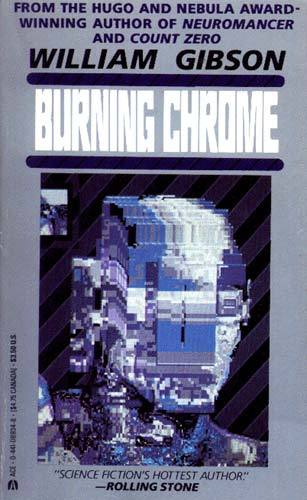This originally appeared in Terry Carr's Universe 11, reprinted in Bruce Sterling's seminal look at cyberpunk, Mirrorshades, two historical genre anthologies--Edel Brosnan's The SF Collection and Ursula K. Le Guin & Brian Attebery's The Norton Book of Science Fiction--and in Paula Geyh, Fred G. Leebron & Andrew Levy's Postmodern American Fiction, among others. It's easy to see why Cyberpunk upset the prior generation of SF writers, yet despite its antagonistic statement, William Gibson went on to receive nominations and win several awards during early in his career. This story is more or less an unmanifested cyberpunk manifesto, which as most manifestos do, goes against all that has come before, beginning with Gernsback romantic ideas of fictionalizing scientific concepts (see title).
The first-person narrator is paid to photograph the futuristic architecture of the 30s and 40s. At futuristic gas station (oil juxtaposed against future), he opines:
"those strange radiator flanges... were a signature motif of the style..., look[ed] as though they might generate potent burst of raw technological enthusiasm, if you could only find the the switch that turned them on. I shot one in San Jose an hour before the bulldozers arrived."First, "potent burst of raw technological enthusiasm" would be the earlier generations painted as technological enthusiasts (with the humorous jab in the "switch" statement). "I shot" pays double duty--both literal and figurative--both uses displays the display is about to get killed or bulldozed. It is "a 1980 that never happened. An architecture of broken dreams."
The narrator arrives in Tucson and a hallucinatory experience where the land reflects back the dreams of a future from the 30s, the perfection of which he will later have to wash from his mind using a healthy dose of reality:
"They were smug, happy, and utterly content with themselves and their world. And in the Dream, it was their world.... [A description of the Dream follows.] It had all the sinister fruitiness of Hitler Youth propaganda."I'm not sure it could be put any more boldly. The challenge/examination is worth heeding, even if it's reductionistic and even if Gibson's own works have become susceptible to the same criticism except from the opposite angle. Pessimistic challenges such as these are as valid as their opposites. Also, William Gibson--a major figure in contemporary SF--uses this early in his collection to mark how his work will be a departure from what has gone before.


No comments:
Post a Comment